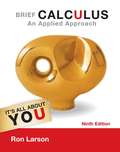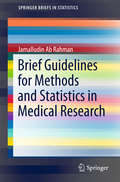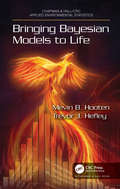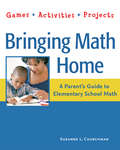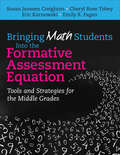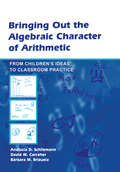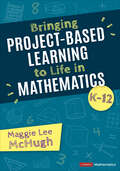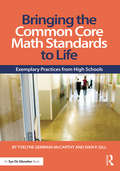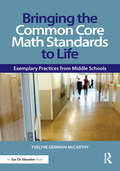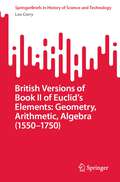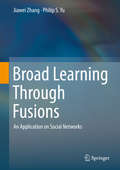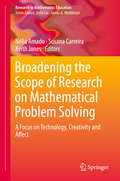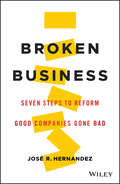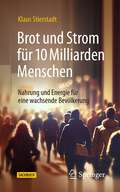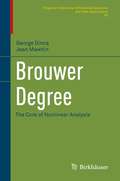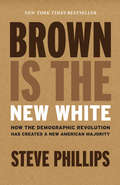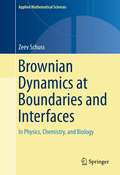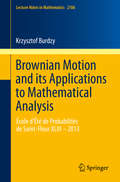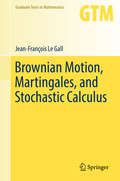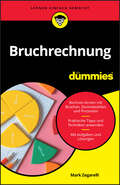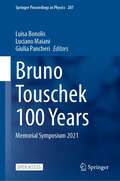- Table View
- List View
Brief Calculus: An Applied Approach (Ninth Edition)
by Ron LarsonDesigned specifically for business, economics, or life/social sciences majors, BRIEF CALCULUS: AN APPLIED APPROACH, Ninth Edition, motivates students while fostering understanding and mastery. The book emphasizes integrated and engaging applications that show students the real-world relevance of topics and concepts. Applied problems drawn from government sources, industry, current events, and other disciplines provide well-rounded examples and appeal to students' diverse interests. The Ninth Edition builds upon its applications emphasis through updated exercises and relevant examples. Pedagogical features--from algebra review to study tips--provide extra guidance and practice.
Brief Guidelines for Methods and Statistics in Medical Research (SpringerBriefs in Statistics #0)
by Jamalludin Ab RahmanThis book serves as a practical guide to methods and statistics in medical research. It includes step-by-step instructions on using SPSS software for statistical analysis, as well as relevant examples to help those readers who are new to research in health and medical fields. Simple texts and diagrams are provided to help explain the concepts covered, and print screens for the statistical steps and the SPSS outputs are provided, together with interpretations and examples of how to report on findings. Brief Guidelines for Methods and Statistics in Medical Research offers a valuable quick reference guide for healthcare students and practitioners conducting research in health related fields, written in an accessible style.
Bringing Bayesian Models to Life (Chapman & Hall/CRC Applied Environmental Statistics)
by Mevin B. Hooten Trevor J. HefleyBringing Bayesian Models to Life empowers the reader to extend, enhance, and implement statistical models for ecological and environmental data analysis. We open the black box and show the reader how to connect modern statistical models to computer algorithms. These algorithms allow the user to fit models that answer their scientific questions without needing to rely on automated Bayesian software. We show how to handcraft statistical models that are useful in ecological and environmental science including: linear and generalized linear models, spatial and time series models, occupancy and capture-recapture models, animal movement models, spatio-temporal models, and integrated population-models. Features: R code implementing algorithms to fit Bayesian models using real and simulated data examples. A comprehensive review of statistical models commonly used in ecological and environmental science. Overview of Bayesian computational methods such as importance sampling, MCMC, and HMC. Derivations of the necessary components to construct statistical algorithms from scratch. Bringing Bayesian Models to Life contains a comprehensive treatment of models and associated algorithms for fitting the models to data. We provide detailed and annotated R code in each chapter and apply it to fit each model we present to either real or simulated data for instructional purposes. Our code shows how to create every result and figure in the book so that readers can use and modify it for their own analyses. We provide all code and data in an organized set of directories available at the authors' websites.
Bringing Math Home: Games, Activities, Projects
by Suzanne ChurchmanThis ultimate parents' guide to elementary school math features projects, games, and activities children and parents can do together to increase their understanding of basic math concepts. Fun activities such as mapping a child's bedroom for practice in measurements or keeping a diary of numeric items like vacation mileage and expenses reinforce the math skills outlined in each lesson. Using the standards issued by the National Council of Teachers of Mathematics as a foundation, this book covers both content and process standards for areas such as algebra, geometry, measurement, problem solving, and reasoning/proofs. It also includes a glossary of math terms and dozens of suggestions for additional children's reading to further math understanding.
Bringing Math Students Into the Formative Assessment Equation: Tools and Strategies for the Middle Grades
by Cheryl Rose Tobey Emily R. Fagan Ms Susan Creighton Eric E. KarnowskiMake formative assessment work for you—and your math students! Finally, formative assessment that adds up! This research-based, teacher-tested guide, written specifically for middle school mathematics teachers, will help you teach more effectively and turn your students into self-regulated learners. As you implement instructional strategies, your students will start monitoring, assessing, and communicating about their own progress. Features include: A clear and manageable six-aspect instructional model Detailed strategies for helping students own their successes Real-life examples from middle school mathematics teachers Useful resources and a companion website to help you implement formative assessment in your classroom
Bringing Math Students Into the Formative Assessment Equation: Tools and Strategies for the Middle Grades
by Cheryl Rose Tobey Emily R. Fagan Ms Susan Creighton Eric E. KarnowskiMake formative assessment work for you—and your math students! Finally, formative assessment that adds up! This research-based, teacher-tested guide, written specifically for middle school mathematics teachers, will help you teach more effectively and turn your students into self-regulated learners. As you implement instructional strategies, your students will start monitoring, assessing, and communicating about their own progress. Features include: A clear and manageable six-aspect instructional model Detailed strategies for helping students own their successes Real-life examples from middle school mathematics teachers Useful resources and a companion website to help you implement formative assessment in your classroom
Bringing Out the Algebraic Character of Arithmetic: From Children's Ideas To Classroom Practice (Studies In Mathematical Thinking And Learning Ser.)
by David W. Carraher Analúcia D. Schliemann Bárbara M. BrizuelaBringing Out the Algebraic Character of Arithmetic contributes to a growing body of research relevant to efforts to make algebra an integral part of early mathematics instruction, an area of studies that has come to be known as Early Algebra. It provides both a rationale for promoting algebraic reasoning in the elementary school curriculum and empirical data to support it.The authors regard Early Algebra not as accelerated instruction but as an approach to existing topics in the early mathematics curriculum that highlights their algebraic character. Each chapter shows young learners engaged in mathematics tasks where there has been a shift away from computations on specific amounts toward thinking about relations and functional dependencies. The authors show how young learners attempt to work with mathematical generalizations before they have learned formal algebraic notation.The book, suitable as a text in undergraduate or graduate mathematics education courses, includes downloadable resources with additional text and video footage on how students reason about addition and subtraction as functions; on how students understand multiplication when it is presented as a function; and on how children use notations in algebraic problems involving fractions. These three videopapers (written text with embedded video footage) present relevant discussions that help identify students' mathematical reasoning. The printed text in the book includes transcriptions of the video episodes in the CD-ROM.Bringing Out the Algebraic Character of Arithmetic is aimed at researchers, practitioners, curriculum developers, policy makers and graduate students across the mathematics education community who wish to understand how young learners deal with algebra before they have learned about algebraic notation.
Bringing Project-Based Learning to Life in Mathematics, K-12 (Corwin Mathematics Series)
by Maggie Lee McHughGo beyond problem-solving and performance tasks. Bring project-based learning to life! Do you want your students to be more engaged in their mathematics lessons while also amplifying cultural relevancy and equity? If so, proceed to the next level of instruction with project-based learning (PBL)! This book provides the whole PBL game plan designed by an experienced, award-winning teacher and researcher. Whether you want to start with small steps or you are ready for full implementation in your classroom, project-based learning experiences can lead to forever memories and deeper learning for your students. Answering the why, what, and how of embarking on the journey toward PBL, readers will find Need-to-Know questions to open each chapter Student and educator vignettes to identify stumbling blocks and successes PBL Plus Tips that identify those small steps teachers can make to gradually shift toward PBL Your Turn prompts to actively connect ideas to your practice This approachable guide includes everything you need to move from tasks to memorable project-based experiences that leverage student voice and choice and build a welcoming classroom culture!
Bringing Project-Based Learning to Life in Mathematics, K-12 (Corwin Mathematics Series)
by Maggie Lee McHughGo beyond problem-solving and performance tasks. Bring project-based learning to life! Do you want your students to be more engaged in their mathematics lessons while also amplifying cultural relevancy and equity? If so, proceed to the next level of instruction with project-based learning (PBL)! This book provides the whole PBL game plan designed by an experienced, award-winning teacher and researcher. Whether you want to start with small steps or you are ready for full implementation in your classroom, project-based learning experiences can lead to forever memories and deeper learning for your students. Answering the why, what, and how of embarking on the journey toward PBL, readers will find Need-to-Know questions to open each chapter Student and educator vignettes to identify stumbling blocks and successes PBL Plus Tips that identify those small steps teachers can make to gradually shift toward PBL Your Turn prompts to actively connect ideas to your practice This approachable guide includes everything you need to move from tasks to memorable project-based experiences that leverage student voice and choice and build a welcoming classroom culture!
Bringing the Common Core Math Standards to Life: Exemplary Practices from High Schools
by Yvelyne Germain-McCarthy Ivan GillAs high school math teachers shift to the Common Core State Standards, the question remains: What do the standards actually look like in the classroom? This book answers that question by taking you inside of real Common Core classrooms across the country. You’ll see how exemplary teachers are meeting the new requirements and engaging students in math. Through these detailed examples of effective instruction, you will uncover how to bring the standards to life in your own classroom! Special Features: A clear explanation of the big shifts happening in the classroom as a result of the Common Core State Standards Real examples of how exemplary teachers are using engaging strategies and tasks to teach algebra, geometry, trigonometry, statistics, mathematics across the curriculum, and moreA detailed analysis of each example to help you understand why it is effective and how you can try it with your own students Practical, ready-to-use tools you can take back to your classroom, including unit plans and classroom handouts
Bringing the Common Core Math Standards to Life: Exemplary Practices from Middle Schools
by Yvelyne Germain-McCarthyAs middle school math teachers shift to the Common Core State Standards, the question remains: What do the standards actually look like in the classroom? This book answers that question by taking you inside of real, Common Core classrooms across the country. You’ll see how exemplary teachers are meeting the new requirements and engaging students in math. Through these detailed examples of effective instruction, you will uncover how to bring the standards to life in your own classroom! Special Features:• A clear explanation of the big shifts happening in the classroom as a result of the Common Core State Standards • Real examples of how exemplary teachers are meeting the CCSS by teaching problem solving for different learning styles, proportional reasoning, the Pythagorean theorem, measurements, and more• A detailed analysis of each example to help you understand why it is effective and how you can try it with your own students• Practical, ready-to-use tools you can take back to your classroom, including unit plans and classroom handouts
British Versions of Book II of Euclid’s Elements: Geometry, Arithmetic, Algebra (SpringerBriefs in History of Science and Technology)
by Leo CorryThis book discusses the changing conceptions about the relationship between geometry and arithmetic within the Euclidean tradition that developed in the British context of the sixteenth and seventeenth century. Its focus is on Book II of the Elements and the ways in which algebraic symbolism and methods, especially as recently introduced by François Viète and his followers, took center stage as mediators between the two realms, and thus offered new avenues to work out that relationship in idiosyncratic ways not found in earlier editions of the Euclidean text. Texts examined include Robert Recorde's Pathway to Knowledge (1551), Henry Billingsley’s first English translation of the Elements (1570), Clavis Mathematicae by William Oughtred and Artis Analyticae Praxis by Thomas Harriot (both published in 1631), Isaac Barrow’s versions of the Elements (1660), and John Wallis Treatise of Algebra (1685), and the English translations of Claude Dechales’ French Euclidean Elements (1685). This book offers a completely new perspective of the topic and analyzes mostly unexplored material. It will be of interest to historians of mathematics, mathematicians with an interest in history and historians of renaissance science in general.
Broad Learning Through Fusions: An Application on Social Networks
by Philip S. Yu Jiawei ZhangThis book offers a clear and comprehensive introduction to broad learning, one of the novel learning problems studied in data mining and machine learning. Broad learning aims at fusing multiple large-scale information sources of diverse varieties together, and carrying out synergistic data mining tasks across these fused sources in one unified analytic. This book takes online social networks as an application example to introduce the latest alignment and knowledge discovery algorithms. Besides the overview of broad learning, machine learning and social network basics, specific topics covered in this book include network alignment, link prediction, community detection, information diffusion, viral marketing, and network embedding.
Broadening the Scope of Research on Mathematical Problem Solving: A Focus on Technology, Creativity and Affect (Research in Mathematics Education)
by Keith Jones Susana Carreira Nélia AmadoThe innovative volume seeks to broaden the scope of research on mathematical problem solving in different educational environments. It brings together contributions not only from leading researchers, but also highlights collaborations with younger researchers to broadly explore mathematical problem-solving across many fields: mathematics education, psychology of education, technology education, mathematics popularization, and more. The volume’s three major themes—technology, creativity, and affect—represent key issues that are crucially embedded in the activity of problem solving in mathematics teaching and learning, both within the school setting and beyond the school. Through the book’s new pedagogical perspectives on these themes, it advances the field of research towards a more comprehensive approach on mathematical problem solving. Broadening the Scope of Research on Mathematical Problem Solving will prove to be a valuable resource for researchers and teachers interested in mathematical problem solving, as well as researchers and teachers interested in technology, creativity, and affect.
Broken Business: Seven Steps to Reform Good Companies Gone Bad
by José R. HernandezHow to prevent corporate scandals and fix good companies that do wrong The news media is replete with stories of corporate scandal, corruption and misdeeds. The need for effective crisis management and corporate governance strategies has never been greater. Broken Business explains why corporate scandals happen, what to do when scandals arise in your company, and how to prevent their future occurrence. Offering real-world anecdotes and solutions, this book details how corporations can mitigate the risk of scandal, reform corporate image and install structures to create a more ethical and profitable company. This insightful resource dispels common misconceptions of corporate misconduct and its causes through fascinating research into human nature, and compelling storytelling that demonstrates fundamental flaws in corporate culture. Author José Hernandez draws on decades of experience working with high-profile global corporations to present seven essential steps for transforming a company, including building a better culture, more effective compliance systems and re-focusing the strategy. This book allows you to: Examine current and highly publicized cases of corporate scandal and their impact on corporate credibility Employ practical methods to rehabilitate your corporation’s public image Implement managerial frameworks to quickly address cases of misconduct Promote a culture of compliance and integrity to encourage good conduct in your corporate environment At its core, this book is a simple, engaging “how to” guide that offers practical advice on institutionalizing integrity in any organization. Broken Business: Seven Steps to Reform Good Companies Gone Bad is an essential text for leaders seeking a concise review at how things can go wrong, how to deal with scandal fallout and how to ultimately become a better company.
Brot und Strom für 10 Milliarden Menschen: Nahrung und Energie für eine wachsende Bevölkerung
by Klaus StierstadtWie lange liefert die Sonne genug Energie für unsere wachsende Bevölkerung?Reichen unsere Dächer aus, um ausreichend Solarstrom zu erzeugen?Stellen Pflanzen und Algen genug Nahrung und Sauerstoff für alle Lebewesen bereit?Millionen Menschen hungern. Strom ist für Milliarden Menschen ein Traum oder zumindest ein Luxusgut. Diese Buch diskutiert mit Hilfe verständlich dargestellter Physik wie weit es zu wenig Ressourcen gibt und wie weit es schlicht eine Problem der Verteilung ist.Das Buch ist gleichermaßen geeignet für Interessierte wie für Personen mit physikalischer Ausbildung. Zahlreiche Vergleiche und Erklärungen zeichnen ein anschauliches Bild, welches durch zahlreiche Abschätzungen und physikalische Details ergänzt wird.
Brouwer Degree: The Core of Nonlinear Analysis (Progress in Nonlinear Differential Equations and Their Applications #95)
by Jean Mawhin George DincaThis monograph explores the concept of the Brouwer degree and its continuing impact on the development of important areas of nonlinear analysis. The authors define the degree using an analytical approach proposed by Heinz in 1959 and further developed by Mawhin in 2004, linking it to the Kronecker index and employing the language of differential forms. The chapters are organized so that they can be approached in various ways depending on the interests of the reader. Unifying this structure is the central role the Brouwer degree plays in nonlinear analysis, which is illustrated with existence, surjectivity, and fixed point theorems for nonlinear mappings. Special attention is paid to the computation of the degree, as well as to the wide array of applications, such as linking, differential and partial differential equations, difference equations, variational and hemivariational inequalities, game theory, and mechanics. Each chapter features bibliographic and historical notes, and the final chapter examines the full history. Brouwer Degree will serve as an authoritative reference on the topic and will be of interest to professional mathematicians, researchers, and graduate students.
Brown Is the New White
by Steve PhillipsDespite the abundant evidence from Obama's victories proving that the U.S. population has fundamentally changed, many progressives and Democrats continue to waste millions of dollars chasing white swing voters. Explosive population growth of people of color in America over the past fifty years has laid the foundation for a New American Majority consisting of progressive people of color (23 percent of all eligible voters) and progressive whites (28 percent of all eligible voters). These two groups make up 51 percent of all eligible voters in America right now, and that majority is growing larger every day. Failing to properly appreciate this reality, progressives are at risk of missing this moment in history-and losing.A leader in national politics for thirty years, Steve Phillips has had a front-row seat to these extraordinary political changes. A civil rights lawyer and a senior fellow at the Center for American Progress, Phillips draws on his extensive political experience to unveil exactly how people of color and progressive whites add up to a new majority, and what this means for U.S. politics and policy. A book brimming with urgency and hope, Brown Is the New White exposes how far behind the curve Democrats are in investing in communities of color-while illuminating a path forward to seize the opportunity created by the demographic revolution
Brownian Dynamics at Boundaries and Interfaces: In Physics, Chemistry, and Biology (Applied Mathematical Sciences #186)
by Zeev SchussBrownian dynamics serve as mathematical models for the diffusive motion of microscopic particles of various shapes in gaseous, liquid, or solid environments. The renewed interest in Brownian dynamics is due primarily to their key role in molecular and cellular biophysics: diffusion of ions and molecules is the driver of all life. Brownian dynamics simulations are the numerical realizations of stochastic differential equations that model the functions of biological micro devices such as protein ionic channels of biological membranes, cardiac myocytes, neuronal synapses, and many more. Stochastic differential equations are ubiquitous models in computational physics, chemistry, biophysics, computer science, communications theory, mathematical finance theory, and many other disciplines. Brownian dynamics simulations of the random motion of particles, be it molecules or stock prices, give rise to mathematical problems that neither the kinetic theory of Maxwell and Boltzmann, nor Einstein's and Langevin's theories of Brownian motion could predict.This book takes the readers on a journey that starts with the rigorous definition of mathematical Brownian motion, and ends with the explicit solution of a series of complex problems that have immediate applications. It is aimed at applied mathematicians, physicists, theoretical chemists, and physiologists who are interested in modeling, analysis, and simulation of micro devices of microbiology. The book contains exercises and worked out examples throughout.
Brownian Models of Performance and Control
by J. Michael HarrisonDirect and to the point, this book from one of the field's leaders covers Brownian motion and stochastic calculus at the graduate level, and illustrates the use of that theory in various application domains, emphasizing business and economics. The mathematical development is narrowly focused and briskly paced, with many concrete calculations and a minimum of abstract notation. The applications discussed include: the role of reflected Brownian motion as a storage model, queuing model, or inventory model; optimal stopping problems for Brownian motion, including the influential McDonald-Siegel investment model; optimal control of Brownian motion via barrier policies, including optimal control of Brownian storage systems; and Brownian models of dynamic inference, also called Brownian learning models, or Brownian filtering models.
Brownian Motion and its Applications to Mathematical Analysis: École d'Été de Probabilités de Saint-Flour XLIII – 2013 (Lecture Notes in Mathematics #2106)
by Krzysztof BurdzyThese lecture notes provide an introduction to the applications of Brownian motion to analysis and more generally, connections between Brownian motion and analysis. Brownian motion is a well-suited model for a wide range of real random phenomena, from chaotic oscillations of microscopic objects, such as flower pollen in water, to stock market fluctuations. It is also a purely abstract mathematical tool which can be used to prove theorems in "deterministic" fields of mathematics. The notes include a brief review of Brownian motion and a section on probabilistic proofs of classical theorems in analysis. The bulk of the notes are devoted to recent (post-1990) applications of stochastic analysis to Neumann eigenfunctions, Neumann heat kernel and the heat equation in time-dependent domains.
Brownian Motion, Martingales, and Stochastic Calculus (Graduate Texts in Mathematics #274)
by Jean-François Le GallThis book offers a rigorous and self-contained presentation of stochastic integration and stochastic calculus within the general framework of continuous semimartingales. The main tools of stochastic calculus, including Itô's formula, the optional stopping theorem and Girsanov's theorem, are treated in detail alongside many illustrative examples. The book also contains an introduction to Markov processes, with applications to solutions of stochastic differential equations and to connections between Brownian motion and partial differential equations. The theory of local times of semimartingales is discussed in the last chapter. Since its invention by Itô, stochastic calculus has proven to be one of the most important techniques of modern probability theory, and has been used in the most recent theoretical advances as well as in applications to other fields such as mathematical finance. Brownian Motion, Martingales, and Stochastic Calculus provides a strong theoretical background to the reader interested in such developments. Beginning graduate or advanced undergraduate students will benefit from this detailed approach to an essential area of probability theory. The emphasis is on concise and efficient presentation, without any concession to mathematical rigor. The material has been taught by the author for several years in graduate courses at two of the most prestigious French universities. The fact that proofs are given with full details makes the book particularly suitable for self-study. The numerous exercises help the reader to get acquainted with the tools of stochastic calculus.
Bruchrechnung für Dummies (Für Dummies)
by Mark ZegarelliGut erklärt und unterhaltsam geschrieben. So macht Bruchrechnen Spaß! Wer mathematische Brüche versteht, besitzt beste Grundlagen für das Erlernen mathematischer Zusammenhänge. Mark Zegarelli erklärt praxisorientiert und anschaulich, wie Brüche, Dezimalzahlen und Pro-zente zusammenhängen und wie man damit rechnet. Sie lernen intuitiv das Addieren, Subtrahieren, Multiplizieren und Dividieren von Brüchen mit ganzen und gemischten Zahlen und üben Prozentrechnung. Der Autor unterstützt Sie mit Tipps, lässt Sie Beispielaufgaben rechnen und hilft Ihnen beim Finden des Lösungswegs. Dieses didaktisch durchdachte Buch macht nicht nur Schülern Spaß! Sie erfahren Warum Bruchrechnung so wichtig ist Was Brüche mit Pro-zenten zu tun haben Was die »Popcorn-Methode« ist Wie Sie Bruchrechnung praktisch im Alltag einsetzen
Bruno Touschek 100 Years: Memorial Symposium 2021 (Springer Proceedings in Physics #287)
by Luciano Maiani Luisa Bonolis Giulia PancheriThis open access book celebrates the contribution of Bruno Touschek to theoretical physics and particle colliders in Europe. It contains direct testimonials from his former students, collaborators, and eminent scientists, among them, two Nobel Prize winners in Physics, Giorgio Parisi and Carlo Rubbia. It reviews the main developments in theoretical and accelerator physics in the second half of the twentieth century, while at the same time providing an overview of future prospects worldwide. This book is unique in that it will be of interest to historians of physics and also to the younger generation of researchers. Through the contribution of the leading protagonists, the interested scholar will learn about the past, present status, and relevance of both theoretical and experimental accelerator physics. The overview of Bruno Touschek’s life and works across Europe, from pre-war Vienna to Germany, the UK, Italy, and France, adds a human dimension to the scientific narration, while the open access status makes this laudatory book available to anyone with interest.
Bryce DeWitt's Lectures on Gravitation: Edited by Steven M. Christensen (Lecture Notes in Physics #826)
by Steven M. Christensen Bryce DewittBryce DeWitt, a student of Nobel Laureate Julian Schwinger, was himself one of the towering figures in 20th century physics, particularly renowned for his seminal contributions to quantum field theory, numerical relativity and quantum gravity. In late 1971 DeWitt gave a course on gravitation at Stanford University, leaving almost 400 pages of detailed handwritten notes. Written with clarity and authority, and edited by his former student Steven Christensen, these timeless lecture notes, containing material or expositions not found in any other textbooks, are a gem to be discovered or re-discovered by anyone seriously interested in the study of gravitational physics.
